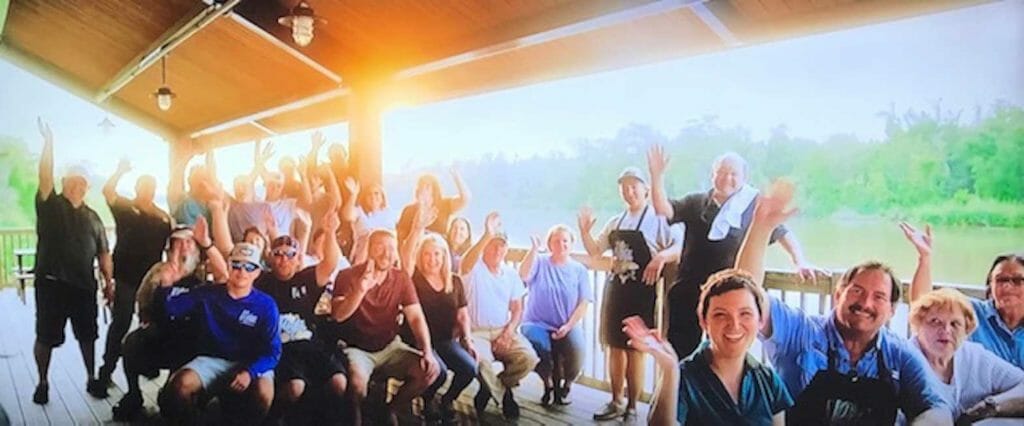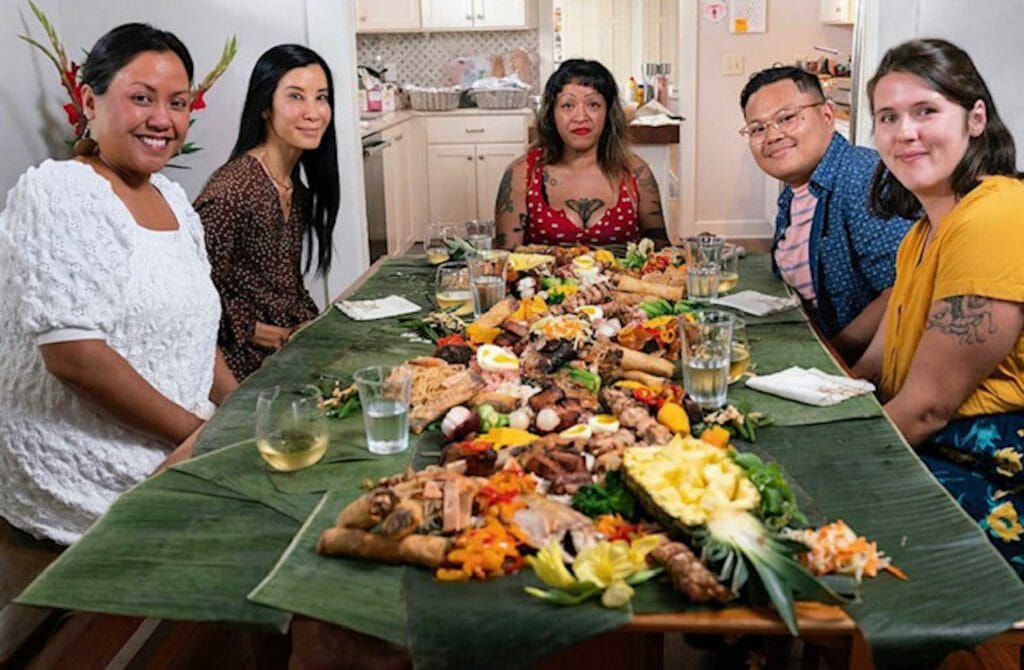Filipino settlers’ descendants in Louisiana show ancestral pride in new HBO Max series

Descendants of John Rojas sail on Barataria Bay where their ancestors first settled. SCREENSHOT CMQM
The latest television series to probe American diversity through food serves up the story of the less known but perhaps longest entrenched Filipino community in the United States.
“Take Out with Lisa Ling” premiered Jan. 26 on HBO Max with “Mix Mix,” a mélange of tales about Filipinos living in the New Orleans area, whose forebears built a vibrant settlement on the waters of what centuries later would become Louisiana in the future southern United States.
Individual and collective stories astound, told by descendants of 18th-century pioneers who “revolutionized the shrimping industry” of this country, as Ling proclaims, and enhanced the regional cuisine already rich with Indigenous, French, and West African ingredients and techniques. There are stories of finding and providing for family where they once feared they were alone, and flaunting an art form reclaimed to showcase ancestral pride.

Jean Lafitte Town Mayor Tim Kerner (right) and grandfather Gordon Rojas survey remnants of Manila Village in Jefferson Parish. SCREENSHOT CMQM
In the genre of televised cultural explorations through cuisine popularized by Anthony Bourdain on CNN’s “Parts Unknown,” “Take Out” focuses on U.S. immigrant communities, more along the vision of Marcus Samuelsson’s “No Passport Required” on PBS. Ling focuses sharply on Asian Americans.
Pathway to belonging
“Restaurants are the pathway for immigrants” to belonging in American society, Ling said on “The View” on the eve of the series premiere. Her own grandparents opened a restaurant in her hometown of Sacramento although they did not know how to cook because they could not find employment despite her grandfather’s MBA, she said.
In a clip showing her with an aunt at the family’s Hop Sing restaurant, she recalls her first taste of chopsuey and egg foo yong, dishes she learned were invented in this country to appeal to non-Chinese palates. She teases with amusing facts, such as New York’s prevalent Indian restaurants owned mostly by folks from Bangladesh.
Host and executive producer Ling, who is known for her investigative journalism on CNN, made no mention of her brand-new series’ first episode, but the title alone is a giveaway to Filipinos. Ling explains the Filipino translation of the title “Mix Mix,” or “halo-halo,” the favorite Filipino dessert combining preserved fruit, beans, coconut sport, flan, puffed rice (Ling says “rice crispies”) and ice cream in milk and crushed ice, is a metaphor for Philippine culture resulting from Malay, Chinese, Spanish and American influences.
“What gumbo is to New Orleans, halo-halo is to the Philippines,” she declares, among other discoveries.
The location of Episode 1 alone is a revelation even to Filipino Americans. Hawaii and California are known Filipino American hubs. New York, New Jersey, Illinois, Florida and Nevada, too, boast large Filipino communities. They have blended into the mainstream, their presence palpable in all strata of society.
But who knew that Tim Kerner, the mayor of Jean Lafitte, a town on Barataria Bay near New Orleans, is a Filipino American? And that he is one of some 200 relatives who trace their roots to one Filipino?
Discovering Manila Village
That’s a startling find by Ling and the dramatic opener for her series, maybe even to students of Filipino American studies who did not know till the 1980s about the “Manila Men” from now-retired University of New Orleans head librarian Maria Espina.

Fil-Am community leader Jessica Bayuga (from left), “Take Out” host Lisa Ling, chef Christina Quackenbush, pop-up restaurateur Ronnie Dacula and girlfriend Erin about to dive into a “kamayan” feast. LISA LING INSTAGRAM
In 1969 Espina, whose husband was a consul with the Philippine consulate, “discovered” the existence of Filipino Cajuns when she met Jacinto Esmele, a community leader who told her about Manila Village. Fellowships in Mexico and China allowed her to dig deeper into the Galleon Trade, ultimately leading her to the stowaways’ 1765 landing in St. Malo in St. Bernard Parish (as County is called in the state) on the Gulf of Mexico.
The Filipinos overcame the bayou’s natural challenges and then relocated to Jefferson Parish, where they built Manila Village, Espina recalls in her book, naming Quintin DelaCruz as founder of the settlement.
Ancestral resolve
The present-day historic marker affirms Espina’s findings. Jean Lafitte Mayor Tim Kerner, a member of the prolific Rojas clan, points to posts jutting out of the water to tell Ling what’s left of the settlement after it was ravaged by Hurricane Betsy in 1965.
Kerner joins his grandfather, Gordon Rojas, in expressing admiration for their ancestors’ resolve to live amid “mosquitoes, alligators, tropical storms and hurricanes” and thrive in the swamps. That’s why they’re proud to identify as Filipinos, they said.
Values and virtues like “sacrifice,“ “resilience,” “survivors,” “family” and “assimilation” echo from Filipinos U.S.-born and raised, or recently arrived, who always gather around food. Images of Filipino and Filipino-inspired delectables seduce the viewer who can almost smell the “bagoong” in Peche, famed for the gumbo by Philippine –born chef Nicole Mills, or savor the mountain of gastronomic pleasures on banana leaves for a “kamayan” or bare-handed feast. “Boodle fight,” someone should tell Ling, is nouvelle term Filipinos in the Philippines these days use to refer to the extravagant buffet.
Chef Christina Quackenbush whose mission is to include Filipino cuisine to the mainstream clientele, teaches Ling how to dig in. “Squish gently,” she invites. “Push with the thumb,” chef Ronnie Dacula demonstrates. Dacula was sent by his father to the U.S. 12 years ago to become a nurse to “help those back home,” but he switched goals because cooking appealed more. Dacula stars in his own pop-up and catering business with his supportive girlfriend and her mother, non-Filipinos who proved to him that “you have family still.”
There’s the typical scene of multigenerational Filipinos partaking of the Philippine national dish made by Joseph Madrigal at his restaurant-cum-community center Cebu Lechon, but only after saying grace in front of the steaming chafing dishes. Karaoke and line dancing follow as expected.

“Grandma Fun” uniquely asserts her identity. SCREENSHOT CMQM
What’s not typical is the entertainment choice of Grandma Fun, who defies the ideation of her stage name. Over her concoction of Ube Horchata, she divulges that at six years old she was ripped from her grandmother’s arms “by two airport security guards” in Manila to join her overseas worker mother on the flight to New Orleans. In America she had to find herself, having lost her identity and being constantly told what to do.
There’s no explanation for her name, which only half-suggests her nocturnal performing art. She is confident in her burlesque number – proud of her lush brown anatomy as it undulates in light and shadow while she sways and turns, and bats eyelashes at her spectators. Ling leads the whoops and applause, tosses dollar bills in appreciation.
The performer believes this is the mainstream’s concept of Philippine identity, which she reclaims, makes her own and throws back at them to ponder. Another serving of food for thought from an empowered New Orleans Filipina American.

